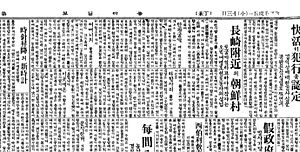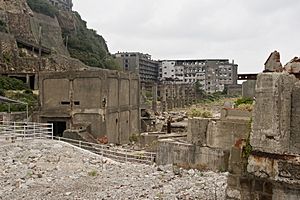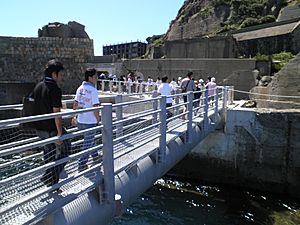Hashima Island facts for kids
|
Native name:
端島
Nickname: Battleship Island
|
|
|---|---|
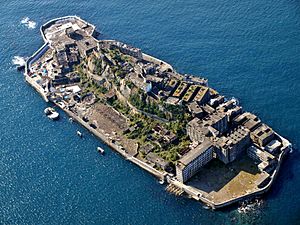
Aerial view
|
|
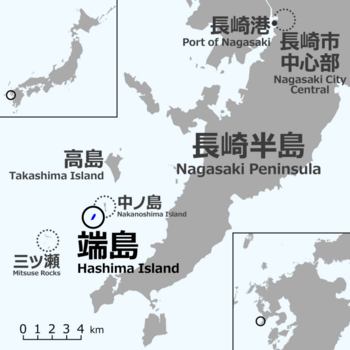 |
|
| Geography | |
| Location | Northeast Asia |
| Area | 0.063 km2 (0.024 sq mi) |
| Area rank | none |
| Administration | |
| Prefecture | |
| City | |
| Demographics | |
| Population | 0 (2016) |
Hashima Island (端島, or simply Hashima, as -shima is a Japanese suffix for island), commonly called Gunkanjima (軍艦島; meaning Battleship Island), is an abandoned island of Nagasaki, lying about 15 kilometers (9 miles) from the center of the city. It is one of 505 uninhabited islands in Nagasaki Prefecture. The island's most notable features are its abandoned concrete buildings, undisturbed except by nature, and the surrounding sea wall. While the island is a symbol of the rapid industrialization of Japan, it is also a reminder of Japanese war crimes as a site of forced labour prior to and during the Second World War.
The 6.3-hectare (16-acre) island was known for its undersea coal mines, established in 1887, which operated during the industrialization of Japan. The island reached a peak population of 5,259 in 1959. In 1974, with the coal reserves nearing depletion, the mine was closed and all of the residents departed soon after, leaving the island effectively abandoned for the following three decades. Interest in the island re-emerged in the 2000s on account of its undisturbed historic ruins, and it gradually became a tourist attraction. Certain collapsed exterior walls have since been restored, and travel to Hashima was re-opened to tourists on April 22, 2009. Increasing interest in the island resulted in an initiative for its protection as a site of industrial heritage.
The coal mine of the island was formally approved as a UNESCO World Heritage Site in July 2015, as part of Japan's Sites of Japan's Meiji Industrial Revolution: Iron and Steel, Shipbuilding and Coal Mining.
Etymology
Battleship Island is an English translation of the Japanese nickname for Hashima Island, Gunkanjima (gunkan meaning warship, but often mistranslated by the Japanese as battleship, jima being the rendaku form of shima, meaning island). The island's nickname came from its resemblance to the Japanese battleship Tosa.
History
Coal was first discovered on the island around 1810, and the island was continuously inhabited from 1887 to 1974 as a seabed coal mining facility. Mitsubishi Goshi Kaisha bought the island in 1890 and began extracting coal from undersea mines, while seawalls and land reclamation (which tripled the size of the island) were constructed. Four main mine-shafts (reaching up to 1 kilometre deep) were built, with one actually connecting it to a neighbouring island. Between 1891 and 1974 around 15.7 million tons of coal were excavated in mines with temperatures of 30°C and 95% humidity.
In 1916 the company built Japan's first large reinforced concrete building (a 7 floor miner's apartment block), to accommodate their burgeoning ranks of workers. Concrete was specifically used to protect against typhoon destruction. Over the next 55 years, more buildings were constructed, including apartment blocks, a school, kindergarten, hospital, town hall, and a community centre. For entertainment, a clubhouse, cinema, communal bath, swimming pool, rooftop gardens, shops, and a pachinko parlour were built for the miners and their families.
Beginning in 1930s and until the end of the Second World War, conscripted Korean civilians and Chinese prisoners of war were forced to work under very harsh conditions and brutal treatment at the Mitsubishi facility as forced laborers under Japanese wartime mobilization policies. During this period, it is estimated that about 1,300 of those conscripted laborers died on the island due to various dangers, including underground accidents, exhaustion, and malnutrition.
There are official records of 1,162 Japanese, 122 Koreans and 15 Chinese cremated between 1925 and 1945. However, the actual number of deaths may be higher as there is another record stating that "around 722 Chinese workers and 1,442 Korean labourers died on the island by the end of WWII".
In 1959, the 6.3-hectare (16-acre) island's population reached its peak of 5,259, with a population density of 835 people per hectare (83,500 people/km2, 216,264 people per square mile) for the whole island, or 1,391 per hectare (139,100 people/km2) for the residential district.
As petroleum replaced coal in Japan in the 1960s, coal mines began shutting down across the country, and Hashima's mines were no exception. Mitsubishi officially closed the mine in January 1974, and the island was cleared of inhabitants on April 20.
Today its most notable features are the abandoned and still mostly-intact concrete apartment buildings, the surrounding sea wall, and its distinctive profile shape. The island has been administered as part of Nagasaki city since the merger with the former town of Takashima in 2005. Travel to Hashima was re-opened on April 22, 2009, after 35 years of closure.
Current status
The island was owned by Mitsubishi until 2002, when it was voluntarily transferred to Takashima Town. Currently, Nagasaki City, which absorbed Takashima Town in 2005, exercises jurisdiction over the island. On August 23, 2005, landing was permitted by the city hall to journalists only. At the time, Nagasaki City planned the restoration of a pier for tourist landings in April 2008. In addition a visitor walkway 220 metres (722 feet) in length was planned, and entry to unsafe building areas was to be prohibited. Due to the delay in development construction, however, at the end of 2007 the city announced that public access was delayed until spring 2009. Additionally the city encountered safety concerns, arising from the risk of collapse of the buildings on the island due to significant aging.
It was estimated that landing of tourists would only be feasible for fewer than 160 days per year because of the area's harsh weather. For reasons of cost-effectiveness the city considered cancelling plans to extend the visitor walkway further—for an approximate 300 metres (984 feet) toward the eastern part of the island and approximately 190 meters (623 feet) toward the western part of the island—after 2009. A small portion of the island was finally reopened for tourism in 2009, but more than 95% of the island is strictly delineated as off-limits during tours. A full reopening of the island would require substantial investment in safety, and detract from the historical state of the aged buildings on the property.
The island is increasingly gaining international attention not only generally for its modern regional heritage, but also for the undisturbed housing complex remnants representative of the period from the Taishō period to the Shōwa period. It has become a frequent subject of discussion among enthusiasts for ruins. Since the abandoned island has not been maintained, several buildings have collapsed mainly due to typhoon damage, and other buildings are in danger of collapse. However, some of the collapsed exterior walls have been restored with concrete.
Access
When people resided on the island, the Nomo Shosen line served the island from Nagasaki Port via Iōjima Island and Takashima Island. Twelve round-trip services were available per day in 1970. It took 50 minutes to travel from the island to Nagasaki. After all residents left the island, this direct route was discontinued.
Since April 2009 the island has been open for public visits, although there are restrictions by Nagasaki city's ordinance. Sightseeing boat trips around or to the island are currently provided by five operators; Gunkanjima Concierge, Gunkanjima Cruise Co., Ltd., Yamasa-Kaiun, and Takashima Kaijou from Nagasaki Port, and a private service from the Nomozaki Peninsula. Landing access to the island costs ¥300 per person, in addition to the cost of boat travel.
In popular culture
In 2002, Swedish filmmaker Thomas Nordanstad visited the island with a Japanese man named Dotokou, who grew up on Hashima. Nordanstad documented the trip in a film called Hashima, Japan, 2002.
During the 2009 Mexican photography festival FotoSeptiembre, Mexican photographers Guillaume Corpart Muller and Jan Smith, along with Venezuelan photographer Ragnar Chacin, showcased images from the island in the exhibition "Pop. Density 5,000/km2". The exhibition traced urban density and the rise and fall of cities around the world.
In 2009, the island was featured in History Channel's Life After People, first-season episode "The Bodies Left Behind" as an example of the decay of concrete buildings after only 35 years of abandonment.
The island was again featured in 2011 in episode six of a 3D production for 3net, Forgotten Planet, discussing the island's current state, history and unauthorized photo shoots by urban explorers. The Japanese Cultural Institute in Mexico used the images of Corpart Muller and Smith in the photography exhibition "Fantasmas de Gunkanjima", organized by Daniela Rubio, as part of the celebrations surrounding 200 years of diplomacy between Mexico and Japan.
In 2012, the island was featured in the comic series Atomic Robo, where it was used as the secret base of an artificial intelligence created by Alan Turing.
The island has appeared in a number of recent feature films. External shots of the island were used in the 2012 James Bond film Skyfall. The 2015 live-action Japanese films based on the manga Attack on Titan used the island for filming multiple scenes, and 2013 Thai horror film Hashima Project was filmed here. The 2017 South Korean World War II film The Battleship Island fictitiously depicts an attempt by Korean forced labourers to escape the labour camp on the island.
Sony featured the island in a video promoting one of its video cameras. The camera was mounted onto a mini multi-rotor radio-controlled helicopter and flown around the island and through many buildings. The video was posted on YouTube in April 2013.
In 2013 Google sent an employee to the island with a Street View backpack to capture its condition in panoramic 360-degree views and allow users to take a virtual walk across the island. Google also took pictures inside the abandoned buildings, which still contain such items as old black-and-white television sets and discarded soda bottles.
More recently, in 2015, the island was featured in the fourth episode of the Science Channel's series What on Earth. Discussed were the island's history, and it once having been the most densely populated place on earth. The program included satellite images and a tour of many of the buildings.
In the 2018 Netflix series Dark Tourist, the host David Farrier explores the island as a location for dark tourism, guided by former Japanese residents of the community before it was abandoned.
Images for kids
-
Korean Village near Nagasaki City, Japan. Article in the Dong-a Ilbo, 8 June 1922
See also
 In Spanish: Hashima para niños
In Spanish: Hashima para niños


